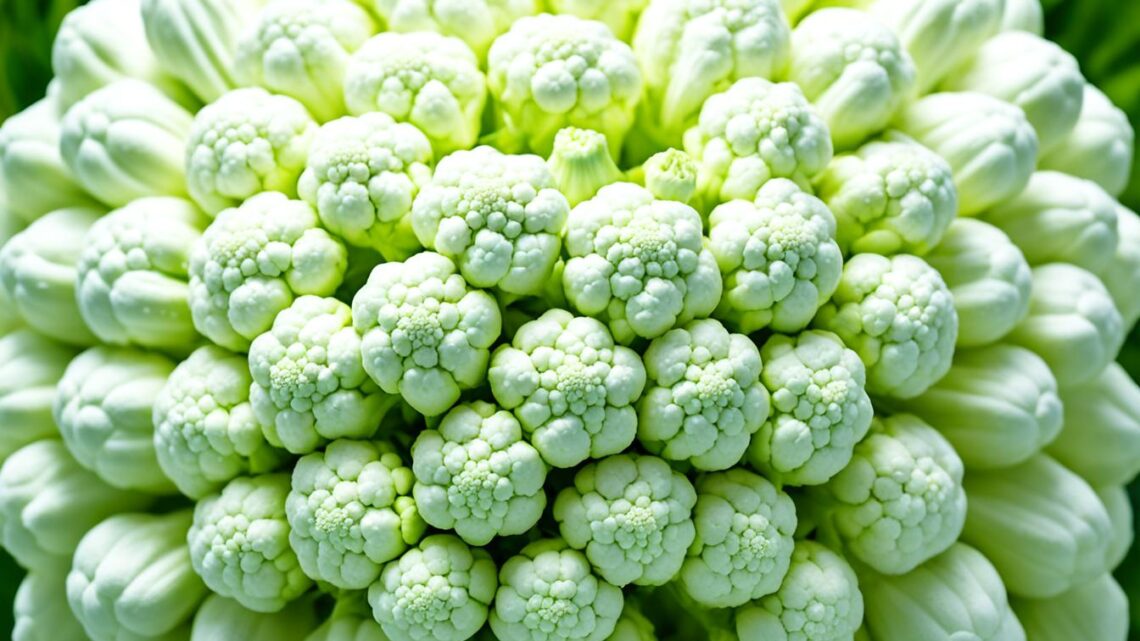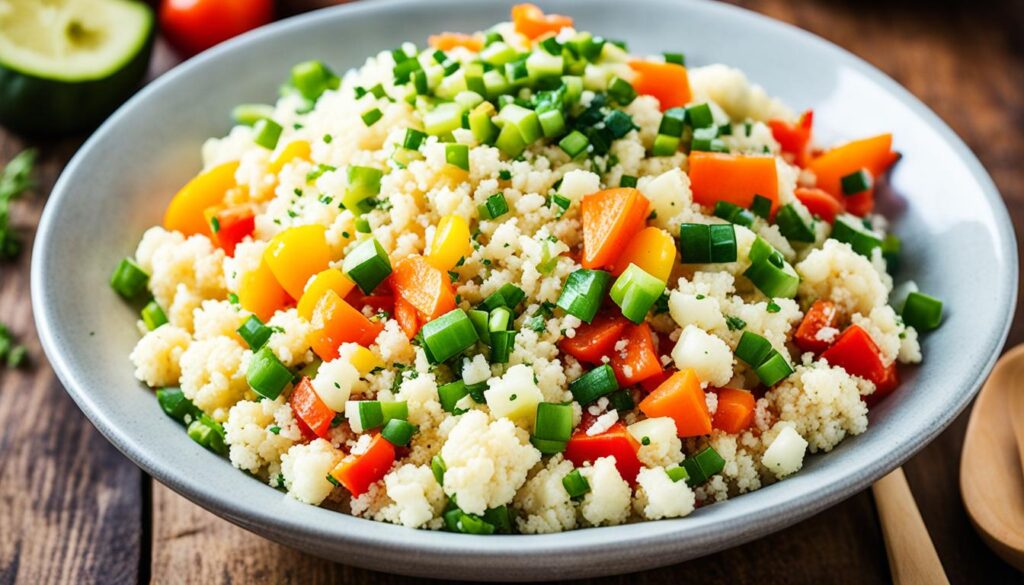
Have you ever thought about how a simple cauliflower can become a star in the kitchen? It’s part of the cruciferous vegetable family, known as Brassica oleracea. This veggie is not just a simple white floret. It’s full of nutrients and can be used in many ways, like roasting, grilling, ricing, or even making a pizza crust.
But what makes cauliflower stand out? And how can you add it to your meals? Let’s look at why this anti-inflammatory, fiber-rich food is great for you.
A single serving of cauliflower has only 25 calories but is full of vitamins, minerals, and antioxidants. It’s also low-carb and can be turned into many dishes. This veggie is becoming a key food for those who care about their health. So, what’s making cauliflower so popular, and how can you use it more?
Cauliflower: A Nutritional Superstar
Cauliflower is not just versatile; it’s a nutritional powerhouse. It’s full of vitamins and minerals. This makes it a great choice for a healthy diet.
Rich in Vitamins and Minerals
A single cup of cauliflower gives you 77% of the daily vitamin C you need. It also has folate, vitamin K, and B vitamins. These are important for staying healthy.
Low in Calories and Carbs
Cauliflower is perfect for those watching their calorie and carb intake. A one-cup serving has only 25 calories and 5 grams of carbs. It’s a nutritious and low-calorie vegetable.
Packed with Fiber
Cauliflower is also full of dietary fiber. A single cup gives you 2 grams of fiber. This is about 10% of what you need daily. Fiber helps keep your digestive system healthy and supports gut health.

Cauliflower is a low-calorie, low-carb, and fiber-rich food. Adding it to your diet can bring many health benefits. It supports your overall wellbeing.
Cauliflower: A Versatile Veggie
Cauliflower is more than just healthy. It’s a great low-carb choice for many dishes. This lets you enjoy your favorite foods without feeling guilty.
Cauliflower Rice: A Low-Carb Alternative
Cauliflower rice is a big win for cutting carbs. Just chop or blend cauliflower into small pieces. Then, it looks and acts like rice in your meals. It has only 25 calories per cup, making it a smart choice for health.
Cauliflower Pizza Crust: Gluten-Free Goodness
Not only can cauliflower make rice, but it also makes a great pizza crust. Mix it with eggs, cheese, and spices to make a crust. This way, you can have pizza without the carbs or gluten.
| Dish | Carbohydrates | Calories | Protein |
|---|---|---|---|
| Cauliflower Rice | 5g | 25 | 2g |
| Cauliflower Pizza Crust | 23g | 220 | 14g |
| Traditional Pizza Crust | 33g | 280 | 11g |

Using cauliflower in your cooking can make your meals healthier. It’s perfect for those who want fewer carbs or a gluten-free option. Cauliflower can change how you see food.
Cauliflower’s Antioxidant Power
Cauliflower is a nutritional powerhouse. It has lots of antioxidants. These help protect your cells from harm and reduce inflammation.
It’s full of glucosinolates and isothiocyanates. These are key antioxidants. They help fight cancer and slow cancer cell growth.
Cauliflower also has carotenoids and flavonoids. These help with heart health and fighting cancer. Eating cauliflower can lower the risk of breast, prostate, and colon cancer.

| Nutrient | Amount in 1 cup (107g) of raw cauliflower | Percentage of Daily Value (DV) |
|---|---|---|
| Vitamin C | 62.8 mg | 58% |
| Vitamin K | 14.5 mcg | 14% |
| Folate | 57 mcg | 15% |
| Choline | 44 mg | 10% |
Eat cauliflower to get its antioxidants for better health. You can have it raw, roasted, or in many recipes. It’s a nutritional superstar.
Weight Loss Friendly Cauliflower
If you’re trying to lose weight, cauliflower is a great choice. It’s low in calories and high in fiber. This makes it perfect for those wanting to lose a few pounds.
Low in Calories and High in Fiber
A single cup of raw cauliflower has only 27 calories. It also gives you 2.2 grams of fiber. This fiber helps you feel full. It can help you eat less and lose weight.
A Water-Rich Veggie
Cauliflower is also very water-rich, with most of its calories from water and carbs. This makes it a filling and hydrating food. It’s great for your weight loss goals.
You can use cauliflower in many ways. Try it as a rice or pizza crust substitute, or just enjoy it roasted or steamed. It’s a smart pick for losing weight in a healthy way.
Choline: Another Cauliflower Benefit
Cauliflower is more than just a tasty veggie. It’s also packed with choline, a key nutrient. Choline keeps cell membranes strong, helps make DNA, and aids metabolism. It also supports brain development and makes neurotransmitters for a healthy nervous system.
Supports Cell Membrane Integrity
Choline is key for cell membranes. It keeps them strong and flexible. This is crucial for cells to work right, especially in the brain and nervous system.
Aids Brain Development
Choline is super important for the brain during pregnancy and early childhood. It helps the brain grow and work better. Getting enough choline can boost memory, focus, and thinking skills in kids and adults.
Many folks don’t get enough choline from food. The daily intake varies, but most Americans don’t hit the recommended levels. Men need 550 mg a day, while women need 425 mg. But the average intake is much lower, around 402 mg for men and 278 mg for women.
Luckily, cauliflower is a great source of choline. Eating more cauliflower can boost your choline levels. This supports your cells, brain, and overall health.
Sulforaphane: Cauliflower’s Cancer-Fighting Compound
Cauliflower is more than just a versatile, low-carb vegetable – it’s a nutritional powerhouse. It has a compound called sulforaphane that fights cancer. This compound is found in cauliflower.
Sulforaphane is an antioxidant that can help stop cancer from growing. Studies show it can slow or stop some cancers. It does this by stopping enzymes that help cancer grow.
This compound does more than fight cancer. It may also help with high blood pressure, keep arteries healthy, and prevent diabetes.
If you want to improve your health and lower disease risk, eat more cauliflower. Sulforaphane in cauliflower could help you live a longer, healthier life.
| Compound | Potential Health Benefits |
|---|---|
| Sulforaphane |
|
To get the most health benefits from cauliflower, eat it fresh and cook it little. Cooking it for over 30 minutes can cut sulforaphane levels by up to 75%. So, eat it raw, lightly steamed, or quickly sautéed to keep its nutritional value high.
Cauliflower: A Low-Carb Alternative to Grains
Cauliflower is a great low-carb choice instead of grains and legumes. It’s full of nutrients and can be used in many dishes. You can make cauliflower rice, cauliflower pizza crust, cauliflower hummus, cauliflower mash, cauliflower tortillas, and even cauliflower mac and cheese.
A cup of cauliflower has just 5 grams of carbs, unlike a cup of rice with 45 grams. This makes cauliflower perfect for low-carb or keto diets. It’s also full of vitamins, minerals, and fiber, making your meals healthier.
Adding cauliflower to your meals lets you enjoy your favorite dishes with fewer carbs. It’s a great way to eat healthier and get more veggies in your diet. Cauliflower is a tasty and nutritious choice for reaching your diet goals.



